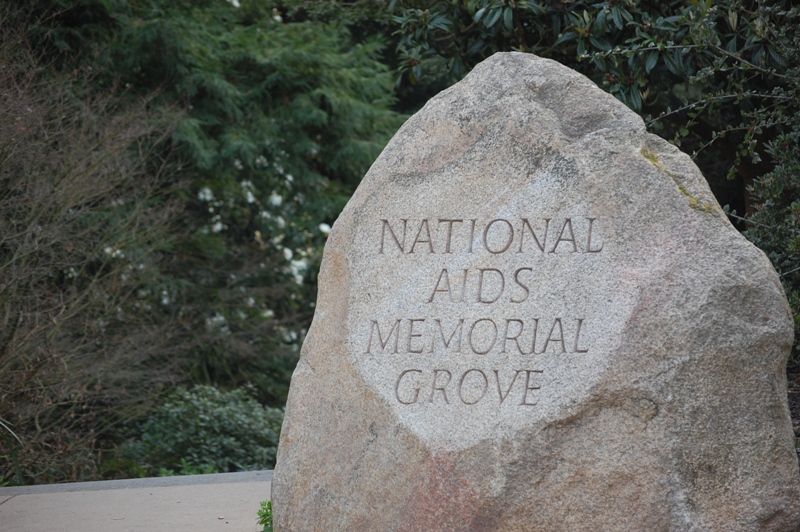The AIDS Epidemic (3 of 4): Community Healing – The National AIDS Memorial Grove
Authors: Carly Solberg, Lillian Guo
Subject: History
Topic: Integrated
Grade Levels: High School: 11th Grade
Overview:
This lesson seeks to bridge students’ own experiences with mourning and healing to those of people affected by the AIDS crisis. It is vital that students understand the serious impact that the AIDS epidemic had and continues to have on lives. In the course of these four connected lesson plans, students will be mentally prepared to enter into the healing space of The Grove.
Time: 50 minutes, plus a half day-long field trip (depending on proximity to Golden Gate Park in San Francisco, CA)
Lesson Plan Resources:
Lesson Objectives:
- Be reminded of the immense impact of the United States AIDS crisis of the 1980s.
- Explore their own ways of mourning and healing using art supplies and their words.
- Learn the history of the National AIDS Memorial in San Francisco, CA and visit the site.
Essential Questions:
- Why is a physical space for mourning important to people? How is it specifically important to those affected by AIDS?
- How does our government lack taking responsibility for the AIDS epidemic?
Standards:
HSS 11.11: Students analyze the major social problems and domestic policy issues in contemporary American society.
HISTORY FRAMEWORK: CH 16 P 427: [Reagan] supported a stronger government that would outlaw abortion and appealed to social conservatives seeking to promote heterosexual marriage, to oppose ratification of the Equal Rights Amendment, to support faith-based cultural advocacy, to champion individual accomplishment, and to oppose many safety-net programs. He also vowed to expand the military and the Cold War. These three areas led to the resurgence of the Republican Party under Reagan as he restructured the scope of the federal government.
HISTORY FRAMEWORK: CH 16 P 431: In what ways have issues such as education; civil rights for people of color, immigrants, and lesbian, gay, bisexual, and transgender (LGBT) Americans, and disabled Americans; economic policy; recognition of economic, social and cultural rights; the environment; and the status of women remained unchanged over time? In what ways have they changed?
The growth of the LGBT rights movement, for example, led to the pioneering role of gay politicians such as Elaine Noble, who was elected to the Massachusetts House of Representatives in 1974, and Harvey Milk, elected in 1977 to the San Francisco Board of Supervisors.
Vocabulary:
Mourning: The expression of deep sorrow for someone or something that has past on, or changed drastically.
Memorial: Something designated to preserve the memory of someone or something.
Teacher Background:
Teacher is encouraged to watch AIDS crisis documentaries such as United in Anger: The History of ACT UP in order to fully understand the intensity of the topic. Teacher must arrange a field trip tour of the National AIDS Memorial.
Materials:
- Internet-connected computer
- A projector
- Colored writing utensils
- Copies of H.R. 3193
- Paper (1 per student)
Instructions:
Pre Field Trip
Presentation and bill analysis (20 mins)
- Open the presentation and review with students what they have learned about the AIDS crisis so far.
- When the slide with H.R. 3193 approaches, pass out one copy of the bill each student. Call on students to read the bill, section by section aloud. Remind students to annotate while they read by highlighting or underlining things that stand out to them, and by taking notes/writing questions in the margins.
- Have students analyze the bill by considering several questions:
- What is the tone of the bill?
- What is missing?
- Are gay people mentioned? Why or why not?
Healing places (20 mins)
- When the “Healing place” slide approaches, pass out pieces of blank paper to each student. Hand out colored writing utensils as well. Give them 10 minutes to write about/draw out their healing spaces.
- Either in a large group, or in pairs, have students share about their healing space. Remind students that they are welcome to share as much or as little as they’d like, but that they should focus on discussing:
- Why their healing space is important to them
- Describing the physical aspects of the healing space
- How their healing space makes them feel personally, and how it impacts/shifts their mood (From what to what? Sad to peaceful? Stressed to calm?)
Conclusion (10 mins)
- Ask the class to discuss as a group why it is important for there to be a physical place of healing specific to the AIDS crisis. Encourage students to connect what they know and understand about their own healing space to answer this question.
- Show the final video in the presentation. Before departing on the field trip, remind students to be aware of their presence at the Grove, and to think about:
- What they see, smell, hear, and touch
- What they experience and feel; what emotions are evoked by being present in the space
- How what they have learned about the AIDS crisis in previous lessons is represented in the space
Relevant Resources:
AIDS Memorial Grove Act of 1996. H.R. 3193, 104th Congress.
Dayton, Tian. “Why We Grieve: The Importance of Mourning Loss.” The Huffington Post, TheHuffingtonPost.com, 3 Apr. 2017.
Litvack, Emily. “How Memorials Make Us Remember-and Forget.” Futurity, 4 Nov. 2016.
“A Timeline of HIV and AIDS.” HIV.gov, 27 Mar. 2018, www.hiv.gov/hiv-basics/overview/history/hiv-and-aids-timeline.
Author Information
Carly Solberg is a Summer 2018 Education Curriculum Intern at Our Family Coalition in San Francisco, CA, and a Women, Gender and Queer Studies student at Sonoma State University in Rohnert Park, CA.
Lillian Guo is an undergrad student studying Learning Sciences at Northwestern University in Evanston, IL, and is a Summer 2018 Education intern at Our Family Coalition in San Francisco, CA.

